Plastic trash on beaches. The worst is on Henderson Island (in Pitcern Islands, South Pacific) where sea currents eject plastic at the coast. In 2017, scientists wrote in the report that there were an estimated 38 million plastic garbage on the island and weighing about 18 tons. They say that every day, 17 to 268 pieces are thrown onto the island through the water, in a 10-meter radius.
The situation on the island is alarming because these plastics, under the influence of wind, water, the sun and other factors, dissolve into plastic sand, which pollutes much of everything around in such a state, destroying the aquatic ecosystem. Many crabs have found plastic plugs instead of shells to hide inside.
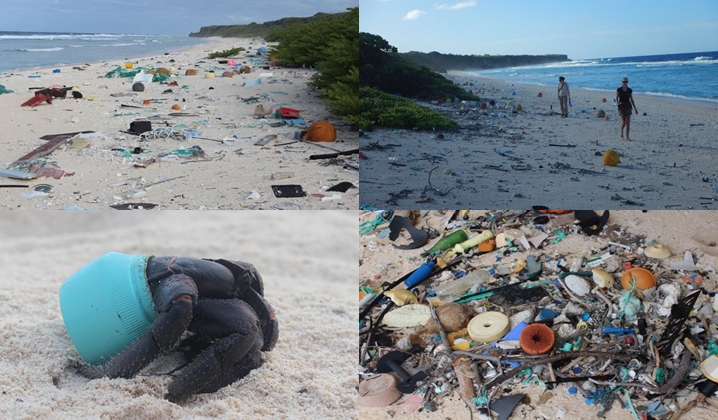
These scenes are just an example of what’s happening across the oceans in the water around the world.
Mangrove destruction in the Caribbean. In Central America, in the Caribbean part is the most grown mangrove on coast and islands. Mangrove is a plant that is very significant because it purifies water, grows on islands, beaches, creates a barrier because it grows out of water, prevents soil erosion, is resistant to winds and as a barrier protects other vegetation from strong winds. Also, because its roots are branched out and in the water, fish, shells and crabs take shelter there. Very useful vegetation.

Otherwise, these islands are called caye, because they are slightly different in composition from the classic islands. The temperature and climate are also tropical, just unlike palm trees and white sand we see different vegetation here.
Unfortunately, in Belize and other places, it is a well-known practice for people to buy islands (in Belize, they are cheaper islands than elsewhere) and completely destroy them, clearing them of mangroves and all other plants to make hotels, houses, resorts themselves it suits them. Not only that, but the massive phenomenon of “island clearing” is contributed by the companies selling the islands themselves, so that customers do not bother to clean the whole island, the companies themselves destroy the island with most of the vegetation to be ready for the buyer to build.
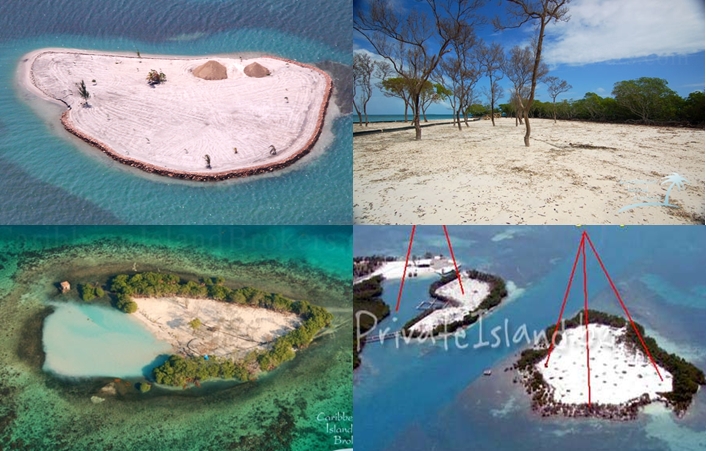
And if they weren’t destroyed, they would look like this:
This is how the cleaned, or rather destroyed islands look, where they have destroyed all or almost all of the vegetation and filled the island with sand.
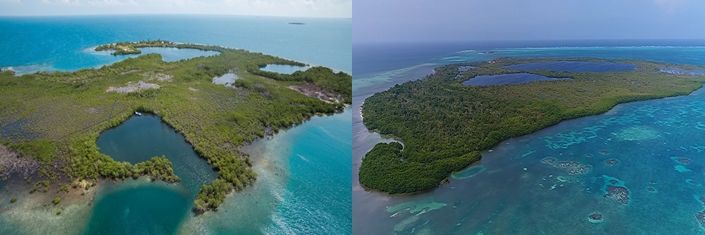
(Lark Caye and Northen Caye, healthy ecosystems with good water penetrating inward, creating swamp alike)
Uncontrolled hunting. It often happens that people fish illegally, and during this process damage the nets with reefs, catch protected endangered species, or fish too deliberately. And so dangerous to the marine world, and therefore to water, as they threaten the ecosystem.
On June 28, 2018, 450 dead sharks in Hawaii were found on the coast. It is assumed that they were trapped on the net and died because they needed to move to breathe. Sharks are from the Hammerhead species.
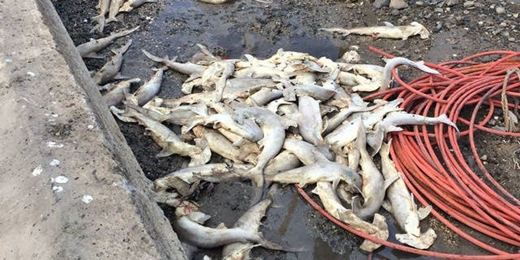
Nuclear testing is a dangerous and biggest problem that has happened since the Second World War. The United States and its allies Britain and France, as well as the Soviet Union, have tested over a thousand official nuclear tests in various places. Mostly on Pacific atolls.
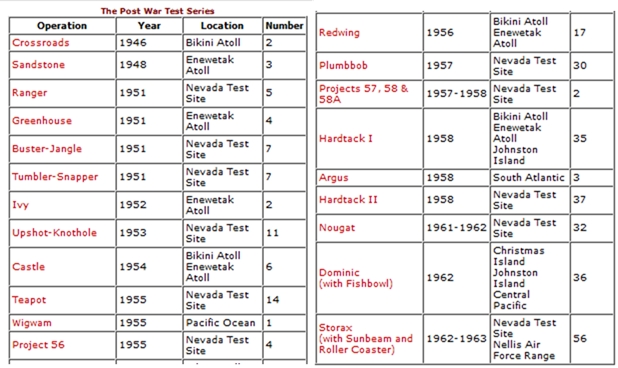
This is the data where the Americans tested nuclear weapons.
Otherwise, in the Pacific alone, there has been a lot of testing officially, and who knows how unofficial.
Heavy nuclear testing caused serious problems in the waters, there was a large number of radiation, tremors caused various earthquakes in the Pacific and around the world, the consequences were enormous. There have been protests around the world for years, and the damage has remained.
Between 1946 and 1996, the United States, Britain and France conducted Cold War nuclear testing programs in the deserts of Australia and the atolls of the central and southern Pacific. Over five decades, more than 315 nuclear tests have been conducted across the region:
-From 1946 to 1958, the United States conducted 67 atomic and hydrogen bomb tests on Bikini and Enevetak atolls in the Marshall Islands. In the 1960s, there were 25 other tests on Christmas Island (Kiritimati) and nine in Johnston Atoll.
-Beginning in 1952, the United Kingdom has tested nuclear weapons in colonies in Australia and the United Kingdom. There were 12 atmospheric tests on the islands of Monte Bello, Maralinga and Emu, Australia (1952-57). Under Operation Grapple, the British government conducted nine more atomic and hydrogen bomb tests on the Kiritimati and Malden Islands in the Gilbert and Ellice Islands Colony, 1957-58
-For 30 years between 1966 and 1996, France also conducted 193 atmospheric and underground nuclear tests at Moruroa and Fangataufa Atolls in French Polynesia.
Heavy nuclear testing caused serious problems in the waters, there was a large number of radiation, tremors caused various earthquakes in the Pacific and around the world, the consequences were enormous. There have been protests around the world for years, and the damage has remained.
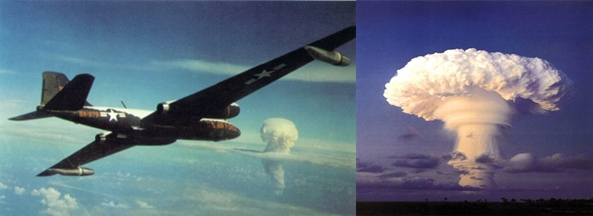
The example of democracy. American testing at the Bikini Atoll in the Marshall Islands, which is an American colony today anyway (under a mask of free association). Marshall Islands suffered a lot because of those testings.

French democracy at Murora Atoll (French Polynesia)
The use of atolls for military purposes was also popular from World War II onwards, as controls of the region and many battles took place there. The atolls were adapted for military purposes, so some even had to be completely destroyed in order to build military facilities on them, because the islands on the atoll did not have the capacity of space for the needs of military complexes. Military bases, naval bases and airports were built, various hangars and ammunition and weapons stores. All this meant that many atolls were destroyed.
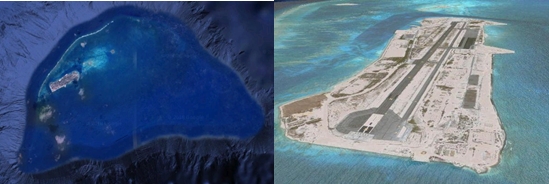
The Johnson Atoll, which belongs to the United States in the Central Pacific, as can be seen, has been completely destroyed beyond recognition.
To make matters worse, there were fighting in those places, where the already damaged nature was further damaged, destroying the surrounding water world completely as result. Even after the fighting, military exercises and various pollution by the military happened there, which in such cases is the biggest polluter, because large ships, planes, submarines with only their exhausts and harmful emissions are on large scales worldwide (in this case the Pacific ) disrupted the ecosystem.
Exploitation of various ores. Many atolls throughout the Pacific have been used to exploit various ores. They made mines, drilled land, installed rails leading to the shore where ships were transported ore further. Large cargo ships coming and going regularly in those places were destroying the reefs, the rails alone for kilometers and machinery were destroying the soil, and digging the soil deeply only amplified the negative impact of man.

Jarvis Island, in the central Pacific that belongs to America is a prime example of mining with consequences
Too much tourism. Unfortunately, that’s a big problem too. As the Caribbean Sea has a great history, and is in a very turbulent location between the United States in the north and South America in the south, the region is in the middle, and has a lot of people and tourism. Lots of planes, heavy ships, oil rigs and too many of civilian boats pass by to such an extent that some places are literally destroyed.

Isla Palominito, Puerto Rico. The island was so beautiful that it was used to shoot a scene in the movie “Pirates of the Caribbean 2011”. Its popularity costed it greatly, because after that it became a huge tourist attraction. The big ships that were passing by island every day were moving their currents of water, which literally caused the erosion of the ground and in a short time destroyed the whole island! Now the island is without any vegetation, it is just sandy! Left Picture, Palominito island before destruction; right picture island after destruction.
Excessive construction. It happens that often due to lack of space and place to be built (due to greed and business cause, of course) companies build in places where it should not build upon. For example, not only that they build resorts on islands and overwater too much, but also on separate shallow lagoons as well without any strong soil beneath, directly risk to damage corals!
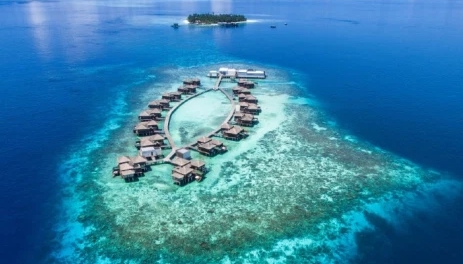
,,Raffles Maldives Meradhoo“ resort in Maldives. Clearly we see overwater bungalows, but no island or vegetation. Construction is placed directly at shallows and corals. Not to be confused with illegal activities, as this is done completely legally, and that is the problem here. Because of money, many things are allowed and legal, at the cost of nature!

